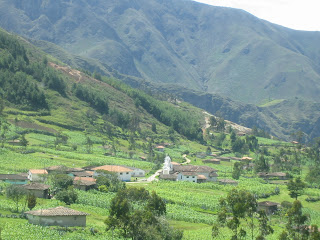We were fortunate to have the opportunity to meet Linda Belote on her recent trip to Saraguro as she passed through Cuenca. We had lunch with her three times during her "short this time" two week stay. Linda tells us that she considers Saraguro "home" and she has lifelong friends there who also consider her to be family.
Over the past several years, Linda has been assisting the women of Saraguro in showing to the world their beautiful bead weaving handiwork. She has worked to have the women of Saraguro included in an international folk art market in Santa Fe -- The Santa Fe International Folk Art Market. If you happen to be in Santa Fe from July 8th - 10th this year, you should try to go. The market is evidently very selective about which artists can enter and you are likely to see some stunning work.
Here is the URL for the market if you'd like to know more: http://www.folkartmarket.org/ If you go to the section on the artist profiles, and check the Western Hemisphere artists, you can see a profile of Maria Balvina from Saraguro who will be at the market this year representing the women of Saraguro.
We were lucky enough meet Maria Balvina when she and Linda came to Cuenca to ship the beadwork that would be sold at the market. Like so many of the people here in Ecuador, she is absolutely gorgeous, sweet and gracious and will be a wonderful representative for the people of Saraguro. Here are Linda (on the left) and Maria Balvina.
That beautiful collar Maria Balvina is wearing is one of the gorgeous bead necklaces that the women of Saraguro make and wear. The hats that Linda and Maria Balvina are wearing are the traditional "everyday wear" hats of the indigenous Saraguro people.
We also had the opportunity to visit Saraguro a few months back. It is a lovely place. The indigenous people there have managed to maintain their cultural identity throughout the years.
This was our local guide in Saraguro, Asuncion Saca, and his lovely daughter. When we arrived in Saraguro, we were fortunate that it was on the anniversary of Saraguro's independence from Spain. There was a big parade and everyone was dressed for the occasion. The clothes that Asuncion and his daughter are wearing are the traditional "special occasion" attire for the indigenous people. Note the black and white designs on the underside of the hats. Also, you'll see that Asuncion's daughter is wearing one of those beautiful beaded necklace collars. In the background, you can see some men in more everyday wear. The men wear short pants and people from Saraguro are very recognizable by their dress when we see them here in Cuenca.
School children in traditional dress in the parade.
Note the beautiful silver broach that the young woman is wearing. This is also part of the traditional dress for the Saraguro women. Today, these broaches are extremely expensive (they are silver), and broaches have been handed down for generations.
A building in beautiful Saraguro.
The countryside around Saraguro is stunning.
We took a hike on a very steep, very narrow trail. The ladies stopped about half-way up, but the men kept on. When they reached the top, they let out a loud scream. This was done to release bad energy, according to Asuncion. Fortunately, we ladies had binoculars with us and were able to verify that the scream didn't result from someone falling off the mountain. Whew! Up there, they were able to see some Inca ruins and also multiple important peaks for the Inca.
Here's Asuncion looking fresh as a daisy after that difficult hike. Difficult for Gringos that is. He is showing the men an Inca astronomical calendar. Water is put into the hole. Heavenly bodies (the moon, stars) are then reflected in the water and depending upon where they are reflected, the people knew the date.
We were also honored to be able to participate in traditional cleansing ceremony. This woman is known as a yacha. She is a spiritual healer. The woman in red is her daughter who is her assistant and yacha in training. We all left the ceremony with much gratitude that we were allowed to share in this experience.
If you'd like to know more about Saraguro, check out Linda & Jim's website at: http://www.saraguro.org/









Great blog, but I'm not sure you are accurate about the women stopping "halfway" up the mountain (at least for me it wasn't accurate).
ReplyDelete:-)
Fond memories. I'm glad you got a chance to meet Linda.
I checked out the folkart blog. What a cool idea and activity. We can't go this year, but how about if all four of us go next summer?
ReplyDeleteOkay, okay, I know. I was trying to be generous to us women. That Folk Art Market does look fascinating. We should keep it in mind next year, but would still rather you just come live here!!
ReplyDeletenot next year, but later....who knows....
ReplyDelete